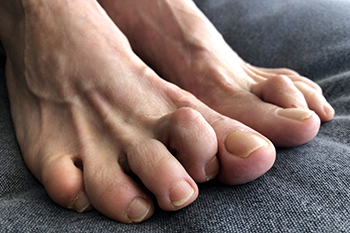
The feet are often taken for granted as we go through our day completing various activities. One ailment, known as hammertoe, gradually develops from genetic factors or from wearing shoes without enough room for the toes to move freely. Hammertoe is a deformity that affects the second, third, and fourth toes. The joints of the toes bend downward and resemble a hammer. Research has shown there are three classifications of hammertoe. Rigid hammertoes are severe and occur when the toes can not move in any direction. Flexible hammertoes are when the affected toes can only move forward and backward. Semi-rigid hammertoes mean the toes become stiff. Hammertoe may cause a decrease in range of motion and completing daily activities may be compromised. If you have any signs of hammertoe, contact a podiatrist as quickly as possible who can provide you with the correct treatment options.
Hammertoe
Hammertoes can be a painful condition to live with. For more information, contact Frederick Matthews, DPM from Innovative Foot and Ankle Care. Our doctor will answer any of your foot- and ankle-related questions.
Hammertoe is a foot deformity that affects the joints of the second, third, fourth, or fifth toes of your feet. It is a painful foot condition in which these toes curl and arch up, which can often lead to pain when wearing footwear.
Symptoms
- Pain in the affected toes
- Development of corns or calluses due to friction
- Inflammation
- Redness
- Contracture of the toes
Causes
Genetics – People who are genetically predisposed to hammertoe are often more susceptible
Arthritis – Because arthritis affects the joints in your toes, further deformities stemming from arthritis can occur
Trauma – Direct trauma to the toes could potentially lead to hammertoe
Ill-fitting shoes – Undue pressure on the front of the toes from ill-fitting shoes can potentially lead to the development of hammertoe
Treatment
Orthotics – Custom made inserts can be used to help relieve pressure placed on the toes and therefore relieve some of the pain associated with it
Medications – Oral medications such as anti-inflammatories or NSAIDs could be used to treat the pain and inflammation hammertoes causes. Injections of corticosteroids are also sometimes used
Surgery – In more severe cases where the hammertoes have become more rigid, foot surgery is a potential option
If you have any questions please contact our office located in Plano, TX . We offer the newest diagnostic and treatment technologies for all your foot and ankle needs.
